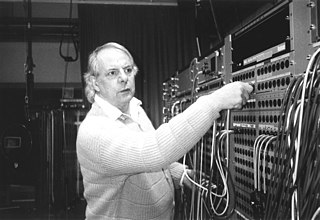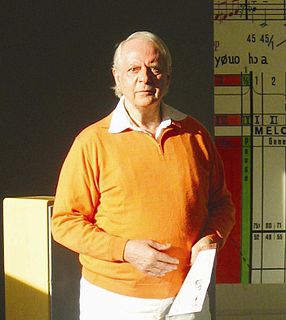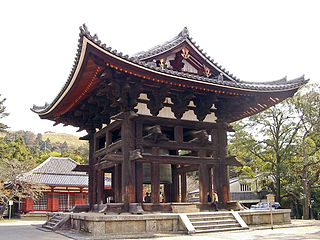Related Research Articles

Karlheinz Stockhausen was a German composer, widely acknowledged by critics as one of the most important but also controversial composers of the 20th and early 21st centuries. He is known for his groundbreaking work in electronic music, for introducing controlled chance into serial composition, and for musical spatialization.

Inori, for one or two soloists with orchestra, is a composition by Karlheinz Stockhausen, written in 1973–74.

Licht (Light), subtitled "Die sieben Tage der Woche", is a cycle of seven operas composed by Karlheinz Stockhausen between 1977 and 2003. The composer described the work as an "eternal spiral" because "there is neither end nor beginning to the week." Licht consists of 29 hours of music.

Ausmultiplikation is a German term used by the composer Karlheinz Stockhausen to describe a technique in which a long note is replaced by shorter "melodic configurations, internally animated around central tones", resembling the ornamental technique of divisions in Renaissance music. Stockhausen first described this technique in connection with his "opus 1", Kontra-Punkte, composed in 1952–53, but in his later formula composition there is a related method of substituting a complete or partial formula for a single very long tone in a much slower, "more background" projection of the formula. When this is done at more than one level, the result is reminiscent of a fractal.
Gruppen for three orchestras (1955–57) is amongst the best-known compositions of German composer Karlheinz Stockhausen, and is Work Number 6 in the composer's catalog of works. Gruppen is "a landmark in 20th-century music ... probably the first work of the post-war generation of composers in which technique and imagination combine on the highest level to produce an undisputable masterpiece".

Kontakte ("Contacts") is an electronic music work by Karlheinz Stockhausen, realized in 1958–60 at the Westdeutscher Rundfunk (WDR) electronic-music studio in Cologne with the assistance of Gottfried Michael Koenig. The score is Nr. 12 in the composer's catalogue of works, and is dedicated to Otto Tomek.
Intuitive music is a form of musical improvisation based on instant creation in which fixed principles or rules may or may not have been given. It is a type of process music where instead of a traditional music score, verbal or graphic instructions and ideas are provided to the performers. The concept was introduced in 1968 by the German composer Karlheinz Stockhausen, with specific reference to the collections of text-notated compositions Aus den sieben Tagen (1968) and Für kommende Zeiten (1968–70). The first public performance of intuitive-music text compositions, however, was in the collective work Musik für ein Haus, developed in Stockhausen's 1968 Darmstadt lectures and performed on 1 September 1968, several months before the first realisations of any of the pieces from Aus den sieben Tagen.

Hymnen is an electronic and concrete work, with optional live performers, by Karlheinz Stockhausen, composed in 1966–67, and elaborated in 1969. In the composer's catalog of works, it is No. 22.

Telemusik is an electronic composition by Karlheinz Stockhausen, and is number 20 in his catalog of works.

Montag aus Licht is an opera by Karlheinz Stockhausen in a greeting, three acts, and a farewell, and was the third of seven to be composed for the opera cycle Licht: die sieben Tage der Woche. The libretto was written by the composer.

In Freundschaft is a composition by Karlheinz Stockhausen, number 46 in his catalogue of works. It is a serial composition for a solo instrument, first for clarinet, and later arranged by the composer for many other instruments, often in friendship to specific performers.

Samstag aus Licht is an opera by Karlheinz Stockhausen in a greeting and four scenes, and was the second of seven to be composed for the opera cycle Licht: die sieben Tage der Woche. It was written between 1981 and 1983, to a libretto written by the composer and incorporating a text by Saint Francis of Assisi, and was first staged in Milan in 1984.

Donnerstag aus Licht is an opera by Karlheinz Stockhausen in a greeting, three acts, and a farewell, and was the first of seven to be composed for the opera cycle Licht: die sieben Tage der Woche. It was written between 1977 and 1980, with a libretto by the composer.

Dienstag aus Licht is an opera by Karlheinz Stockhausen in a greeting and two acts, with a farewell, and was the fourth of seven to be completed for the opera cycle Licht: Die sieben Tage der Woche. It was begun in 1977 and completed from 1988 to 1991, to a libretto by the composer.

Mittwoch aus Licht is an opera by Karlheinz Stockhausen in a greeting, four scenes, and a farewell. It was the sixth of seven to be composed for the opera cycle Licht: die sieben Tage der Woche, and the last to be staged. It was written between 1995 and 1997, and first staged in 2012.

Musik im Bauch is a piece of scenic music for six percussionists and music boxes composed by Karlheinz Stockhausen in 1975, and is Number 41 in his catalog of works. The world premiere was presented on 28 March 1975 as part of the Royan Festival. The performance was given by Les Percussions de Strasbourg in the haras in the town of Saintes, near to Royan. Its duration is roughly 38 minutes.

Zeitmaße is a chamber-music work for five woodwinds composed in 1955–1956 by German composer Karlheinz Stockhausen; it is Number 5 in the composer's catalog. It is the first of three wind quintets written by Stockhausen, followed by Adieu für Wolfgang Sebastian Meyer (1966) and the Rotary Wind Quintet (1997), but is scored with cor anglais instead of the usual French horn of the standard quintet. Its title refers to the different ways that musical time is treated in the composition.

Harlekin (Harlequin) is a composition for unaccompanied clarinet by Karlheinz Stockhausen, named for the commedia dell'arte character Harlequin. It was composed in 1975 and is Number 42 in his catalogue of works. A shorter, derived work called Der kleine Harlekin is Number 42½.

Oktophonie (Octophony) is a 1991 octophonic electronic-music composition by Karlheinz Stockhausen. A component layer of act 2 of the opera Dienstag aus Licht, it may also be performed as an independent composition. It has a duration of 69 minutes.
Unsichtbare Chöre is an eight-channel electronic-music composition by Karlheinz Stockhausen. A component part of the opera Donnerstag aus Licht, it may also be performed as an independent composition, in which form it is designated "ex 49" in the composer's catalog of works.
References
- ↑ Blumröder 1982, pp. 184–185.
- ↑ Conen 1991, p. 57.
- ↑ Stockhausen 1989.
- ↑ Blumröder 1982, pp. 183–184.
- ↑ Stenzl 1991, pp. 12–15.
- ↑ O'Súilleabháin 1992.
Cited sources
- Blumröder, Christoph von. 1982. "Formel-Komposition—Minimal Music—Neue Einfachheit: Musikalische Konzeptionen der siebziger Jahre." In Neuland Jahrbuch 2 (1981/82), edited by Herbert Henck , 183–205. Bergisch Gladbach: Neuland Verlag.
- Conen, Hermann. 1991. Formel-Komposition: Zu Karlheinz Stockhausens Musik der siebziger Jahre. Kölner Schriften zur Neuen Musik 1, ed. Johannes Fritsch and Dietrich Kämper. Mainz: Schott's Söhne. ISBN 3-7957-1890-2.
- O'Súilleabháin, Finbar. 1992. [Letter to the Editor]. Tempo New Series, no. 181 (June): 68.
- Stenzl, Jürg. 1991. "York Höller's The Master and Margarita: A German Opera." Translated by Sue Rose. Tempo New Series, no. 179 (December): 8–15.
- Stockhausen, Karlheinz. 1989. "Multiformale Komposition". In his Texte zur Musik 5, 667. Cologne: DuMont Buchverlag. ISBN 3-7701-2249-6.